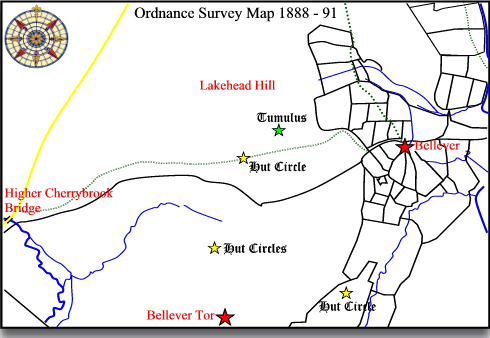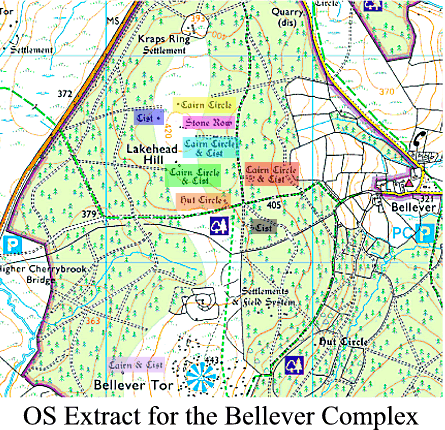
“In fact this picturesque though dilapidated erection under the bold slope of Bellever
is not so often sought out by the explorer as it might be...”
J. Ll. W. Page
The above words were written in 1895 when describing Bellever clapper bridge, I think it’s fairly safe to say that one hundred and nineteen years later the bridge is very much – “sought out by the explorer‘, especially in the summer months. If you are lucky enough to visit ‘out of season’ it can be a very peaceful place to sit and contemplate the meaning of life. Very often a herd of Dartmoor ponies will wander along the nearby river bank which at the right time of year is covered in yellow gorse.
The old Dartmoor place-name for Bellever was in 1355 Welford and by 1663 had mutated to Bellaford, the ‘W’ being a dialect change to ‘B’. It could be that the Wel element derives from the Old English word wiell meaning ‘spring’ which there certainly are a few of them in the vicinity. This would give the ‘ford by the spring‘ ? What both names suggest was the presence of a ford that through which an old trackway in the crossed the East Dart river. In this case it was the ancient Lych path which went to Lydford and was known as The Lychway. When you look at a 3D image of the local landscape it is easy to see why the location of the crossing point was chosen as it gives the easiest descent of Riddon Ridge whilst avoiding the lower and wetter areas to the North. The track then carried onwards to the west and again takes the more gentler climb over Lakehead Hill.
At some point a clapper bridge was built over the East Dart river which possibly replaced the ford as a crossing point. Originally the bridge consisted of twp piers over which three two and a half metre granite slabs spanned. The dimensions of the bridge would have meant that only foot passengers could cross, it certainly would be precarious for anything bigger.
Samuel Rowe gives a description of the clapper bridge when writing in 1848
“Below the modern structure over the East Dart, are the remains of an aboriginal cyclopean bridge of three openings. The rude piers and abutments still remain, and one massive granite slab still spans each of the eastern and western openings; but the centre stone has been displaced, and no trace of it appears in the stream below.”, p.195.
Slightly contradictory, Page remarks as how he was informed that a certain Admiral White visited the clapper some years after 1848 and found that it was intact, p.166fn. Either way at some point in time in the mid to late 1800s the centre slab went mysteriously missing. Normally the finger for such damage would be squarely pointed at a river in full spate, there are such instances of the powerful water surge washing away parts of clapper bridges on Dartmoor. However, in this case William Crossing solved the mystery, Writing in 1889, he relates the following cause of the clapper’s demise:
“I considered that the builders of the new bridge might have thrown it off, and used it in the construction of their erection. A few years ago, however, I discovered the perpetrator of this act of vandalism, a man who still lives on the moor, and who on my happening to refer to the old bridge in the course of conversation, informed me that he, when a boy, with a companion contrived to slide the stone off the piers. This was done solely for mischief...”, p62.
Having established exactly how the slab was ‘dethroned’ the only remaining mystery is what ever happened to it? Various writers have noted the fact that it there was/is no sign of it in the river bed and to move such a weight would have taken considerable effort – clearly though, somebody did.
The Dartmoor Preservation Association at one time had plans to ‘restore’ the clapper bridge but for whatever reason these never came to fruition. In some eyes this was and is a good thing for as J. Ll. W. page wrote: “I hope it never will be, as such restoration is not only unnecessary with the new bridge a few feet above, but will go far towards destroying, or at any rate impairing the charm of this hoar relic of antiquity.”, p.127.
As can be seen below, not only is the central slab still missing but also the one that leads from the west bank. Apart from that everything is very much the way as when Rowe, Crossing and Page viewed it.

In the early 1800s the then rector of Widecombe often made journeys to Postbridge and Princetown which meant crossing the East Dart at Bellever. Presumably this was something of a nuisance for him because it was he that was responsible for building of the second bridge alongside the ancient clapper, Fleming, p.18.
In 1841 an act was passed by the Devon magistrates which stated a durable boundstone, (in Dartmoor’s case – granite) had to be sited three hundred feet either side of bridges. The roads outside of this six hundred foot zone was then the responsibility of the relevant turnpike trust for maintenance. These marker stones are known as ‘C’ or County Stones and in the case of Bellever Bridge both are still in situ.

At the end of August 2014 I planned to visit the bridge to take some photographs for this page. Before leaving home there was a sure sign that Autumn was approaching fast as the only birdsong to be heard greeting the dawn was that of the ‘Winter Songster’ – the Robin. A few days later and Dartmoor will take a huge sigh of relief knowing that the summer visitors have departed for another year. Just like the swallows and martins their flocks have migrated back to more familiar climbs, hopefully taking some good memories with them. After the recent spell of heavy rain I just hoped the predicted weather forecast was correct as it promised bat least a few sunny spells?
Well, true to it’s word Dartmoor provided some sunny spells inter-dispersed with some showers, luckily the former came whilst taking the photographs. What also came was a shock when rolling up into Bellever car park. Admittedly I had not be there for over a year but I did not expect to see a parking metre or pay two pounds for the privilege of parking! I for one am getting hacked off with all these new charges that are springing up in places that always used to be for free. At the moment you can park in the visitor’s centre and are asked for a donation – yeah right. Go a kilometre down the road and you have to pay two pounds to park?
And you can cancel what I said above, the flocks of tourists have not migrated back to their wintering grounds. Ever heard of day-camping? No neither had I until today but the idea is to buy a small, lurid blue tent and stick it on the edge of the river bank along with a hoard of yelling kids. Then set up a field kitchen whilst chucking sticks in the river for the dog to fetch whilst scaring all the wildlife within a five hundred metre radius – so much for a peaceful visit. Don’t get me wrong, I think it’s great that families can enjoy the great outdoors, just gag the kids, leave the dogs at home and keep out of my way. Did I see a dipper bird – no they had all evacuated back up the East Dart, probably as far in as Winney’s Down for a bit of peace and quiet.
Well as you can see, I did manage to get my photographs without the slightest trace of a human form, took a while mind but got there in the end. As it was lunchtime I decided to nip into Princetown to get something to eat – big mistake. Firstly, another pound down the swanee to park which brings me on to something else. Would one expect to drive into a car park and have to swerve around numerous, gaping chasm-like pot-holes (at least 4 inches deep)? Then having bust the shock absorbers and unbalanced the wheels be charge a quid for the privilege even though you are only stopping for five minutes. Oh, I forgot and have to pay to use the toilets as well, methinks someone is taking the proverbial in Princetown. Never mind, only three more days to go!
The only highlight of the day was talking with two pretty blonde ladies in Pork Hill car park who wanted know; a) was I local and b) if so why was the hill called ‘Pork Hill’. Simples – it’s a world famous ‘dogging’ site.

Fleming, A. 2005. The Dartmoor Reaves. Oxford: Oxbow Books.
Page, J. Ll. W. 1893. The Rivers of Devon. London: Seeley and Co.
Page, J. Ll. W. 1895. An Exploration of Dartmoor. London: Seeley and Co.
Rowe, J. Brooking. 1985. A Perambulation of Dartmoor. Exeter: Devon Books.
 Legendary Dartmoor The many aspects past and present of Dartmoor
Legendary Dartmoor The many aspects past and present of Dartmoor
